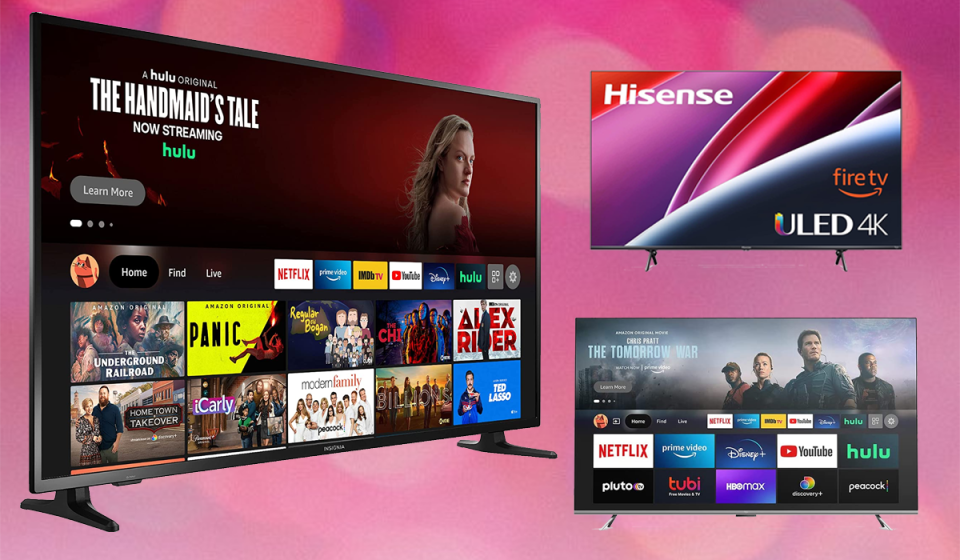The best budget TV must be a small, poor-quality thing that’s bereft of desirable features, right? Not anymore; these days you can get a surprisingly spacious screen for just a few hundred bucks — and for a little more than that, a screen that fills even the largest living rooms.
Quick Overview
There’s more good news: So-called “budget” TVs are better than you’d expect. Even the most basic models offer razor-sharp 4K resolution and built-in streaming software; some add voice controls and Dolby-powered audio to the mix.
Below I’ve rounded up my picks for the best budget TV (65-inch) you can buy right now. That size represents the current “sweet spot” in terms of bang for the buck: Dropping down to a 55-inch model wouldn’t save you much, but jumping to a 70- or 75-inch would cost a fair bit more. Plus, I think a 65-inch is “just right” for the average living room, offering a really good viewing experience for movies, sports, videogames and the like without overwhelming the space.
What about a budget projector?
Before you pull the trigger on a TV, should you look at a projector instead? For about the same money (anywhere from $500-$800), you can enjoy an image of up to 100 inches or even larger, provided you have a blank wall available (or you hang a screen). I’m a big fan of this option, but there’s one key consideration: resolution.
As noted above, all modern TVs are capable of 4K resolution, or 3,480 x 2,160 pixels. The vast majority of under-$1,000 projectors top out at 1080p resolution, or 1,920 x 1,080 pixels. That’s not bad, but it simply doesn’t measure up to 4K. And the bigger your projection, the more pixels you want.
Plus, brightness is always a concern: If you’re looking for something for your living room, a projector may not be bright enough for daytime viewing with the curtains open.
That said, if you want to give this a try, consider the ViewSonic PX701-4K, a native-4K projector that normally sells for $900 but is currently marked down to $800. (Remember, you want native 4K resolution, not simply “supported,” which is the marketing language used with a lot of low-cost projectors.) It’s super-bright and features dedicated modes for movies and gaming.
What to look for in a budget TV
On paper, most modern 65-inch TVs may look the same: 4K Ultra HD (aka UHD) resolution, HDR10, Dolby This-or-That, 3-4 HDMI inputs and so on. OLED display technology will yield the best possible image quality, but that’s hard to find in budget models. Thankfully, QLED and ULED tech, which definitely raises the image-quality game versus standard LED, is available in some of the models listed here.
Speaking of games, anyone planning to connect a current-generation PlayStation or Xbox should look for a TV with a 120Hz refresh rate and, if possible, support for HDMI 2.1. That will ensure you get the best visual experience your game console has to offer.
Crazy though it may sound, the first thing I look for in any TV is the built-in software. Does it run Amazon’s Fire TV operating system? Google’s Android TV? Roku? Or perhaps there’s a proprietary operating system like the ones found in LG and Samsung TVs.
This didn’t matter in the old days, when you just flipped channels or used the cable box TV guide. Now, the OS dictates the look, feel and features of the TV, particularly the streaming apps like Netflix and Hulu. Some interfaces are easier to use than others; some can go beyond basic streaming (like offering games or Zoom calls).
Of course, if you decide you’re not happy with the built-in OS, you can easily plug in a different one: There are streaming sticks and boxes available from Amazon, Apple, Google and Roku, among others. Most game consoles have streaming capabilities as well. So while it’s wise to choose a TV with the operating system you like best, it’s not a forever decision.
But that does bring us back to the number of HDMI inputs, something to think about before buying. If you decide to plug in, say, an Apple TV, that’s one. A cable box? That’s two. Game console? Three. Sound bar? That can plug into an optical audio port, but HDMI is the better option. And that would mean you’d need four HDMI inputs to cover your bases. Figure out how much hardware you’re bringing to the TV table, because running out of ports is no fun.
Beyond that, hands-free voice controls are a nice feature to have, and if you’re planning to add surround-sound speakers, look for Dolby Atmos.
Best budget TV picks (65-inch) for 2022
Proof-positive that a big screen doesn’t have to break the bank, Best Buy’s Insignia F30 is currently priced at just $390 (but has dipped as low as $350). And if you think this model means compromises, think again: It earned a 4.6-star average rating from around 1,400 buyers.
Make no mistake, it doesn’t have fancy features like QLED or Dolby Atmos, but it delivers a solid 4K viewing experience — which is all that matters for many buyers, especially those upgrading from an older and/or smaller TV.
The F30 employs Amazon’s Fire TV OS, which affords access to not only streaming apps but also some pretty cool games. There’s Apple AirPlay support as well, great for viewing iPhone photos and the like on your big screen. Plus, press a button on the remote and you’ve got Alexa at your disposal, ready to act on your spoken commands.
I’d argue that the Roku TV interface is the easiest to use, and therefore the most novice-friendly. That’s something to think about if you’re fairly new to streaming or haven’t used a TV like this before. Roku makes it a breeze to switch between different inputs, and the built-in Roku Channel provides access to a wealth of free movies and TV shows.
This model is also notable for including four HDMI inputs, one of them supporting eARC — important if you plan to connect, say, a sound bar or audio receiver. And although the included IR remote doesn’t support voice commands, the Roku app (for Android and iOS) does. It also makes for a good backup remote in case the regular one gets lost in the couch cushions. I especially like the app’s Private Listening feature, which routes TV audio to your favorite earbuds or headphones.
This is definitely the lower-end model in TCL’s lineup, so don’t expect features like quantum dot or local dimming. But user ratings Amazon, Best Buy and elsewhere are overwhelmingly positive, so if you just want a basic 4K TV with an excellent interface, look no further.
I first reviewed Amazon’s Fire TV Omni Series back in January, and I remain impressed by the picture quality and breadth of features — not the least of which is webcam support, which allows for big-screen Zoom calls. Just plug in a compatible camera and you can enjoy video chats from the comfort of your couch.
Beyond that, the Fire TV operating system — which I dinged in my review for its somewhat unintuitive design — is newly overhauled and better organized than ever. And it plays very nicely with any other Alexa-capable devices you might have in your home, though you certainly don’t need any. On its own, it affords very handy voice-powered TV controls (and hands-free at that).
And you can’t help taking into account Amazon customer ratings, which currently number over 15,000 and average out to 4.6 stars. That means most buyers have been extremely happy with the TV, good to know when you’re making a major purchase.
However, here’s the really important part: Like most Amazon-branded hardware, this frequently goes on sale. It’s rare to see it at $830, the list price; right now, for example, it’s down to $700, but for a long while it sold for $500 — and will almost certainly see a similar discount as the holiday seasons draws near. Bottom line: If you want this TV (and it’s definitely worth considering), wait for a sale.
If you’re a Google-ecosystem fan (Android phone, Nest smart speakers, etc.), it might make sense to choose a TV with the familiar Google TV operating system baked in. That’s what you get from the Hisense U6H Series, which is notable not just for that, but also for frequently discounted pricing and the surprising inclusion of Quantum Dot technology (which promises a wider color spectrum than you get from standard 4K HDR).
In addition, the U6H offers local dimming, which helps improve the contrast in individual areas of the screen (rather than just “across the board”). There’s also Dolby Atmos sound support, great if you’re planning to pair your TV with a surround speaker system, and Dolby Vision and variable refresh rate (VRR) as well — the latter important for gaming.
Hisense backs the U6H series with a 2-year warranty, which is double what you get with most TVs (and, for that matter, most consume electronics).
I’ve owned a similar version of this TV for nearly a year and can’t think of a bad thing to say about it. (OK, it’s not as bright as a few other models I’ve tested, but in a vacuum it’s plenty bright.) I continue to look upon it as a remarkable “budget” TV, especially when you’re able to get it on sale.
Good things come to those who wait: The LG 65NANO90UPA (more commonly referred to as the NanoCell 90) originally sold for $1,500, but you can now scoop one up for less than $900. That feels like getting premium TV at a budget price, or at least budget-friendlier.
Indeed, LG isn’t typically known as a budget brand, and the NanoCell 90 reflects that with features like Dolby Atmos, full-array local-dimming backlights (which improve contrast), two HDMI 2.1 inputs (out of four total) and an IPS panel that delivers wider viewing angles than most. It has special modes for movies and gaming and support for both Alexa and Google Assistant voice commands.
Take note, however, that LG relies on WebOS, an interface that some people love and some don’t. Similarly, LG’s Magic Remote, which employs a motion sensor for a mouse-like onscreen cursor, is divisive: loved by some, hated by others.
Although I haven’t had the chance to test this model myself, user reviews tend to be overwhelmingly positive: 4.6-star average at Best Buy, 4.7 at Walmart. This despite a few professional reviews that have been critical of the TV’s black levels. (There’s a lesson here: TV reviewers tend to obsess over things that aren’t super-important to the average viewer.)
Follow us on Instagram, Facebook, Twitter and Pinterest for nonstop inspiration delivered fresh to your feed, every day.
Want daily pop culture news delivered to your inbox? Sign up here for Yahoo Entertainment & Life’s newsletter.
Originally published September 2, 2022, 11:07 AM




